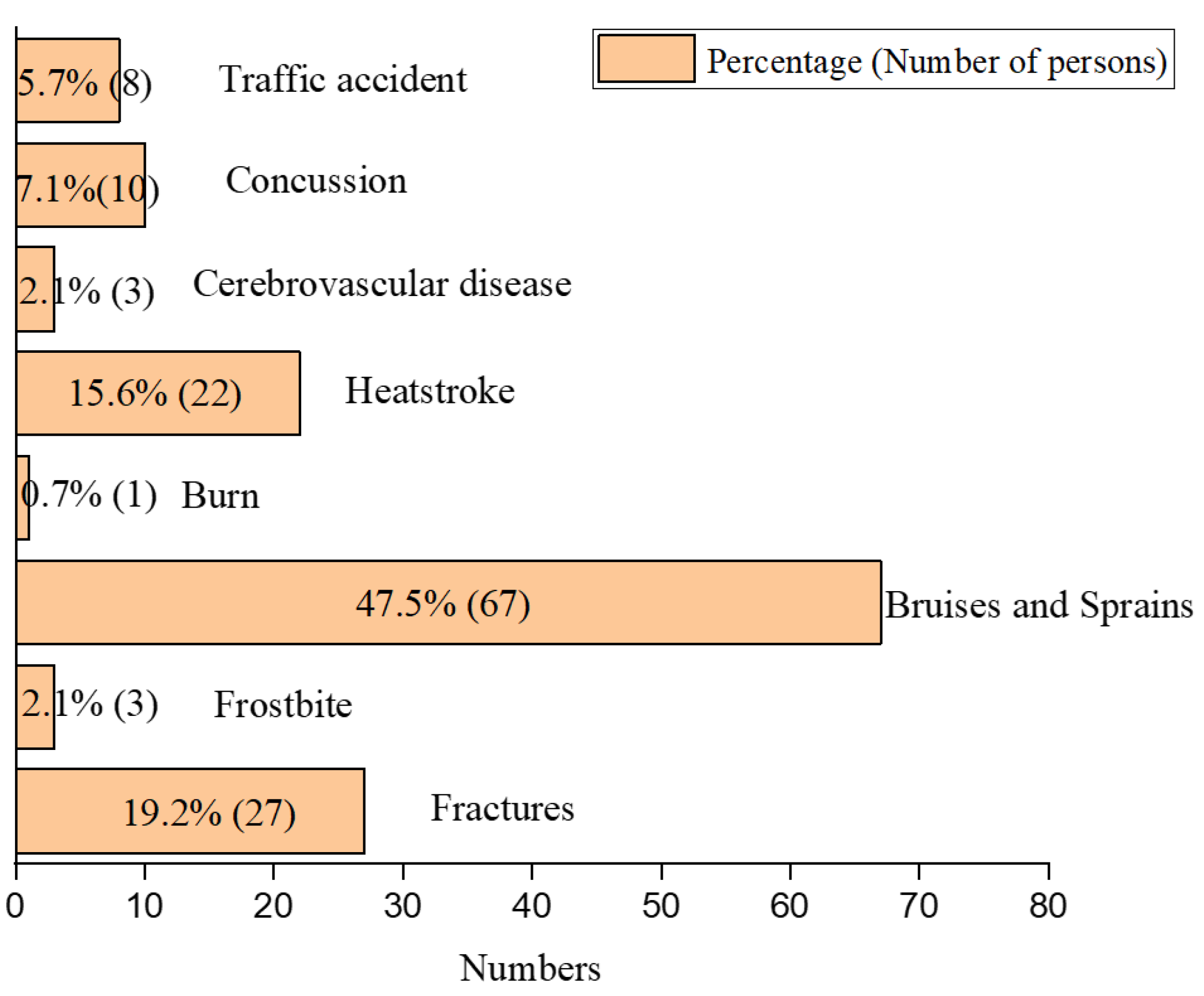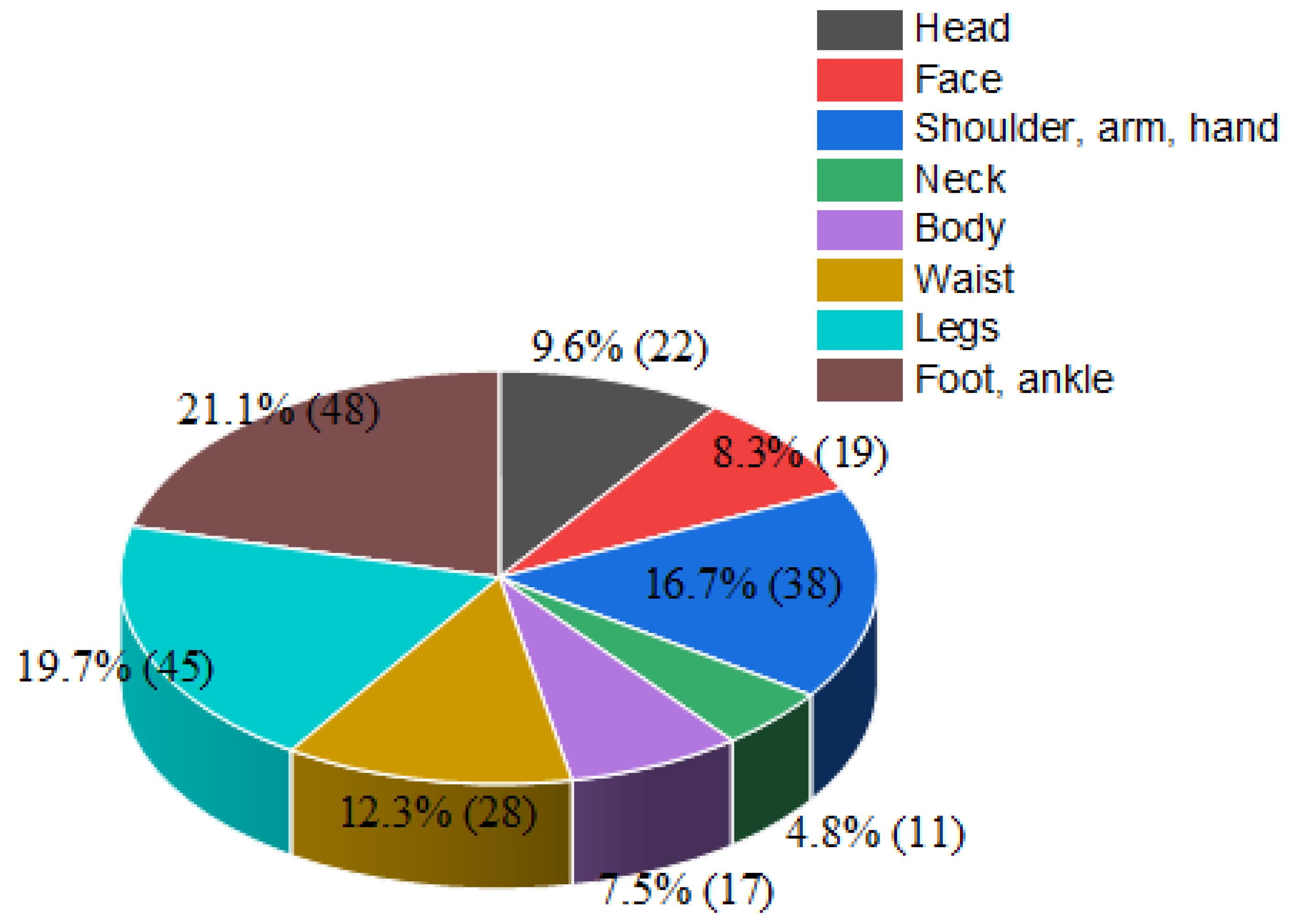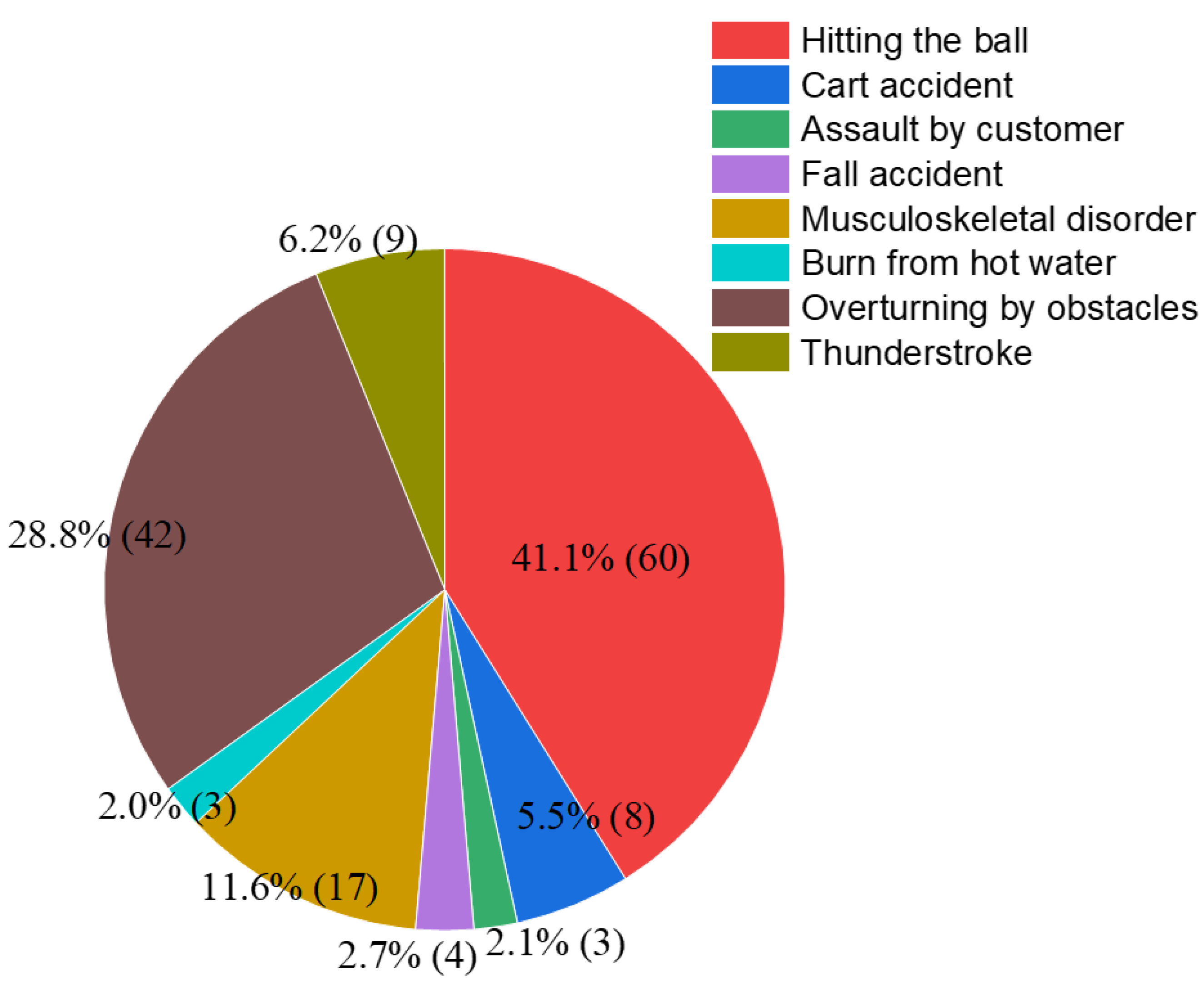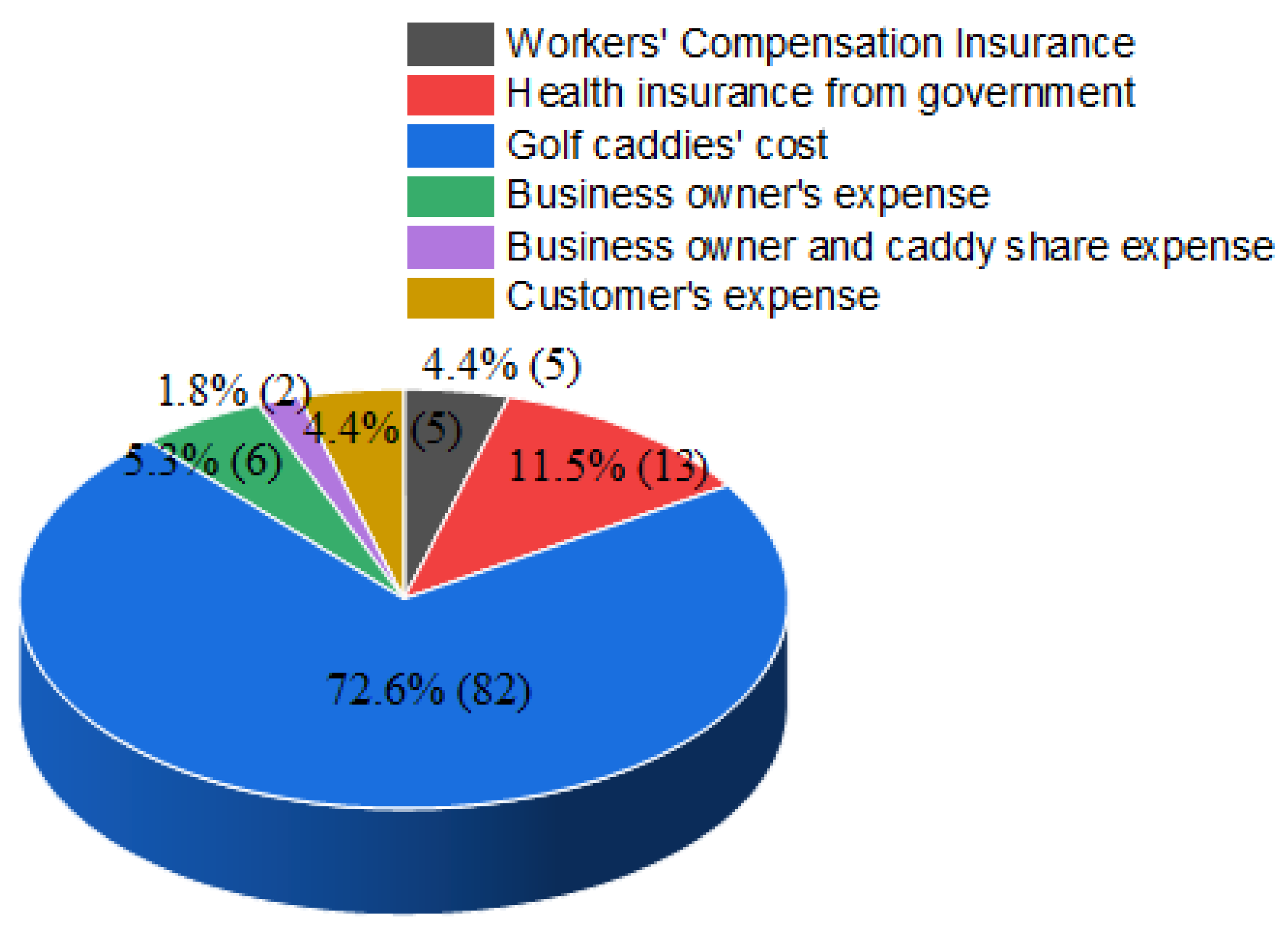A Study on the Status of Safety and Health for Golf Course Caddies and Improvement of Protective Measures in South Korea
Abstract
:1. Introduction
2. Materials and Methods
2.1. Participants
2.2. Survey
2.3. Data Analysis
3. Results
3.1. Participants’ Characteristics
3.2. Safety and Health Status
3.3. Health Protection and Protective Measuresfor Caddies
3.4. Preparation for Golf Cart Operation and Safety Compliance
3.5. Physical Burden and Emotional Labor
3.6. Correlation between Major Factors
4. Discussion
5. Conclusions
- (i)
- The study participants demanded higher safety protective measures for caddies working in small golf courses with fewer than 30 employees.
- (ii)
- Most caddies were aware of the need for regular health checkups. It is necessary to provide follow-up guidance from health managers, based on the expansion of caddies having health checkups and the results of health checkup diagnosis.
- (iii)
- According to the analysis of perceived physical burden, females perceived there to be a higher burden than males, and with regard to age, those in their thirties were more aware of physical burdens than those in their twenties. Therefore, there is a need for attention and protective measures to prevent musculoskeletal disorders in female caddies in their 30 s and 50 s. Caddies should be able to devote sufficient time to warm-up exercises to prevent injuries to players and themselves.
- (iv)
- The experience of receiving safety education for the prevention of musculoskeletal disorders in handling heavy objects and repetitive tasks was very low. Caddies have a very high risk of developing musculoskeletal disorders due to unnatural postures, such as squatting or bending the back due to green maintenance, grass marks, ball picking, pin insertion, and repetitive postures, such as wiping balls, clubs, and cleaning carts. Musculoskeletal disease prevention education that can enable maintenance of the correct working posture should be conducted periodically.
- (v)
- Most golf carts that operate on courses do not have safety belts. To prevent accidents, it is necessary to prepare standards for installing safety facilities, such as seatbelts, and strengthen safety device management.
- (vi)
- To increase golf courses’ response to emotional labor, health protection, protective measures for caddies, compliance with golf cart safety during the game, and lower physical burden should be encouraged. Additionally, the government should identify golf courses’ health and safety status and establish appropriate preventive measures.
Author Contributions
Funding
Institutional Review Board Statement
Informed Consent Statement
Data Availability Statement
Acknowledgments
Conflicts of Interest
References
- Garnett, J.; Made, F.; Tlotleng, N.; Wilson, K.; Naicker, N. Work related musculoskeletal pain in gold caddies-Johannesburg, South Africa. Int. J. Environ. Res. Public Health 2020, 17, 3617. [Google Scholar] [CrossRef] [PubMed]
- Seo, C. Leisure Industry Yearbook 2022, 1st ed.; Korea Leisure Research Institute: Seoul, Korea, 2022; pp. 154–195. [Google Scholar]
- Bruce, D. Turn Up, Keep Up & Shut Up: The Role of a Caddie in Male Professional Gold in Australia. Master’s Thesis, The University of Queensland, Brisbane, Australia, 1999. [Google Scholar]
- Coate, D.; Toomey, M. Do professional golf tour caddies improve player scoring? J. Sports Econ. 2014, 15, 303–312. [Google Scholar] [CrossRef]
- Donald, W.; Winter, S. More than carrying a bag? The role of the caddies in facilitating a golfer’s psychological performance. Sport Exerc. Perform. Psycho. 2022, 11, 124–137. [Google Scholar] [CrossRef]
- Leisure News. Available online: http://www.golftimes.co.kr/ (accessed on 23 June 2022).
- Ministry of Employment and Labor. Available online: https://www.mole.go.kr/user/download/ (accessed on 13 August 2022).
- Jun, H.; Lee, J.E.; Kim, J. A specific case of a female golf caddy in South Korea. Work 2013, 45, 183–189. [Google Scholar]
- Kim, E.; Nakata, M. Work-related musculoskeletal disorders in Korea and Japan: A comparative description. Ann. Occup. Environ. Med. 2014, 26, 17. [Google Scholar] [CrossRef] [PubMed] [Green Version]
- Growing Number of Sexual Crimes by South Korea’s “Power Elite”. Available online: https://english.hani.co.kr/arti/english_edition/e_national/664325.html (accessed on 22 June 2022).
- Golf Cart Accident and Moped Crash Injuries Can Be deadly in South Carolina. Available online: https://www.matthewsandmegna.com/golf-cart-moped-accidents-south-carolina-lawyer (accessed on 12 June 2022).
- How Vulnerable Are “Cart Girls" to Sexual Harassment? Here’s One Woman’s Take After Three Years on the Job. Available online: https://golf.com/news/how-vulnerable-are-cart-girls-to-sexual-harassment-heres-one-womans-take-after-three-years-on-the-job/ (accessed on 18 June 2022).
- CISS. Available online: https://www.kca.go.kr/kca/sub.do?menukey=5012 (accessed on 18 June 2022).
- Kim, I.; Rhie, J.; Yoon, J.; Kim, J.; Won, J. Current situation and issue of industrial accident compensation insurance. Korean Med. Sci. 2012, 27, S47–S54. [Google Scholar] [CrossRef] [PubMed]
- Wadsworth, L.T. When golf hurts: Musculoskeletal problems common to golfers. Curr. Sports Med. Rep. 2007, 6, 362–365. [Google Scholar] [CrossRef]
- Zouzias, I.C.; Hendra, J.; Stodelle, J.; Limpisvasti, O. Golf injuries: Epidemilogy, Pathophysiology, and treatment. J. Am. Acad. Orthop. Surg. 2018, 26, 116–123. [Google Scholar] [CrossRef]
- McHardy, A.; Pollard, H.; Luo, K. One-year follow up study on golf injuries in Australian amateur golfers. Am. J. Sports Med. 2003, 35, 1354–1360. [Google Scholar] [CrossRef]
- Darrow, M. How Carrying Golf Bags Adds to Neck and Back Pain. Available online: https://stemcellinstitute2.com/carrying-a-golf-bag-adds-to-neck-and-back-pain/ (accessed on 8 June 2022).
- Engel, L.; Bansback, N.; Bryan, S.; Doyle-Waters, M.M.; Whitehurst, D.G.T. Exclusion criteria in national health state valuation studies: A systematic review. Med. Decis. Making. 2016, 36, 798–810. [Google Scholar] [CrossRef]
- Jung, M.; Kim, H. Relations between the emotional labor and depression symptoms of female workers in cosmetics sales. J. Oil Appli. Sci. 2018, 35, 1–11. [Google Scholar]
- Korea Occupational Safety and Health Agency (KOSHA), KOSHA Guide H-106-2012 Job Stress Assessment Guidelines. Available online: http://www.kosha.or.kr (accessed on 20 June 2022).
- Taber, K.S. The use of Cronbach’s alpha when developing and reporting research instruments in science education. Res. Sci. Educ. 2018, 48, 1273–1296. [Google Scholar] [CrossRef]
- Golf Cart Accidents & Golf Cart Safety. Available online: http://www.golfcartsafety.com/ (accessed on 23 June 2022).
- Li, C.; Wang, X.; Wei, C.; Hao, M.; Qiao, Z.; He, Y. Analysis of the correlation between occupational accidents and economic factors in China. Int. J. Environ. Res. Public Health 2021, 18, 10781. [Google Scholar] [CrossRef]
- Dancey, C.; Reidy, J. Statistics Without Maths for Psychology, 5th ed.; Prentice Hall: Hoboken, NJ, USA, 2011; p. 175. [Google Scholar]
- Liao, D.; Valliant, R. Variance inflation factors in the analysis of complex survey data. Surv. Methodol. 2012, 38, 53–62. [Google Scholar]
- Murray, C.J.; Vos, T.; Lozano, R.; Naghavi, M.; Flaxman, A.D.; Michaud, C.; Ezzati, M.; Shibuya, K.; Salomon, J.A.; Abdalla, S.; et al. Disability-adjusted life years (DALYs) for 291 diseases and injuries in 21 regions, 1990–2010: A systematic analysis for the Global Burden of Disease Study 2010. Lancet 2013, 380, 2197–2223. [Google Scholar] [CrossRef]
- Paver, R.; Rothman, S.; van den Broeck, A.; de Witte, H. Labour market interventions to assist the unemployed in two townships in South Africa. SA J. Ind. Psychol. 2019, 45, a1596. [Google Scholar] [CrossRef] [Green Version]
- Rischewski, D.; Kuper, H.; Atijosan, O.; Simms, V.; Jofret-Bonet, M.; Foster, A.; Lavy, C. Poverty and musculoskeletal impairment in Rwanda. Trans. R. Soc. Trop. Med. Hyg. 2008, 102, 608–617. [Google Scholar] [CrossRef]
- National Assembly Research Service. Available online: https://www.nars.go.kr/report/view.do?cmsCode=CM0018&brdSeq=2087 (accessed on 29 June 2022).
- Inglis, P. The “Caddie Question”: Why the Golf Caddies of Bangalore Reject Formal Employment. J. Contemp. Ethnogr. 2018, 47, 579–608. [Google Scholar] [CrossRef]
- Occupational Safety and Health Administration. Long Work Hours, Extended or Irregular Shifts, and Worker Fatigue. Available online: https://www.osha.gov/worker-fatigue (accessed on 17 August 2022).
- Brumitt, J.; Cuddeford, T. Current concepts of muscle and tendon adaptation to strength and conditioning. Int. J. Sports Phys. Ther. 2015, 10, 748–759. [Google Scholar]
- Giaccone, M.; Nunzio, D.D.; Fromm, A.; Vargas, O. Violence and Harassment in European Workplaces: Extent, Impacts and Policies; Eurofound: Dublin, Ireland, 2015; pp. 1–89. [Google Scholar]
- Golf Cart Safety Fact Sheet. Available online: https://www.tdi.texas.gov/pubs/videoresource/fsgolfcart.pdf (accessed on 14 August 2022).
- Carrillo-Castrillo, J.; Pérez-Mira, V.; Pardo-Ferreira, M.D.C.; Rubio-Romero, J.C. Analysis of required investigations of work-related musculoskeletal disorders in Spain. Int. J. Environ. Res. Public Health 2019, 16, 1682. [Google Scholar] [CrossRef] [Green Version]
- Comper, M.L.C.; Dennerlein, J.T.; Evangelista, G.D.S.; Rodridues da Silva, P.; Radula, R.S. Effective of job rotation for preventing work-related musculoskeletal diseases: A cluster randomized controlled trial. Occup. Environ. Med. 2017, 74, 545–552. [Google Scholar] [CrossRef] [PubMed] [Green Version]
- Moar, J.M.; Alvarez-Campana, J.M.; Míguez, J.L.; González, L.M.; Ramos, D.G. Comparative study of the relevance of musculoskeletal disorders between the Spanish and the European working population. Work 2015, 51, 645–656. [Google Scholar] [CrossRef] [PubMed]
- Occupational Safety and Health Administration. Available online: https://www.osha.gov/quicktakes/05202021 (accessed on 18 August 2022).




| Classification | Detailed Questionnaire |
|---|---|
| Health protection | Regular health checkups, follow-up guidance by health managers, and recognition of emergency procedures |
| Protective measures for golf caddies | Safety education, verbal abuse from customers, sexual harassment protective measures, workplace harassment prevention |
| Preparation for golf cart operation | Risk awareness of cart operation, safety education, cart checklist before work |
| Physical burden | Heavy work, education on the prevention of musculoskeletal disorders, a correlation between work and musculoskeletal disorders, risk of musculoskeletal disorders |
| Compliance with golf cart safety during the game | Hazard factors that may occur during operation and observance when driving a cart |
| Golf course’s response to emotional labor | Assault, verbal abuse, and sexual harassment by customers, golf course response to protect caddies, development of customer response manual |
| Classification | Detail Information | Mean | Standard Deviation (S.D.) | Cronbach’s Alpha |
|---|---|---|---|---|
| Health protection | Necessity of regular health checkups | 3.89 | 0.91 | 0.803 |
| Necessity of consultation with a health manager after health checkups | 3.39 | 1.05 | ||
| Familiarity with emergency procedures | 3.53 | 0.91 | ||
| Familiarity with the location of the first aid kit | 3.46 | 1.10 | ||
| Whether or not to take measures, such as suspending the game during extreme cold and extreme heat | 2.82 | 1.22 | ||
| Education on using a defibrillator and performing CPR | 3.71 | 1.17 | ||
| First aid measures in case of injuries caused by animals | 2.55 | 1.10 | ||
| Tips for first aid in case of an accident caused by hitting the ball | 3.54 | 1.03 | ||
| Actions and safety rules in case of a lightning strike | 3.36 | 1.13 | ||
| Protective measures | Necessity of regular safety and health education | 3.22 | 0.96 | 0.802 |
| Implementing protective measures in case of customer verbal abuse or assault | 2.96 | 1.13 | ||
| Implementing protective measures in case of sexual harassment | 3.05 | 1.12 | ||
| Implementing protective measures in case of workplace harassment | 3.04 | 1.11 |
| Classification | Detail Information | Mean | Standard Deviation (S.D.) | Cronbach’s Alpha |
|---|---|---|---|---|
| Golf cart preparation | Dangers when driving a golf cart | 3.44 | 1.03 | 0.886 |
| Training experience on how to operate and the hazards before driving a cart | 4.05 | 0.72 | ||
| Golf cart preparation before use (1) Charge the cart before driving | 4.57 | 0.58 | ||
| (2) Tire damage, wear, and air pressure before cart operation | 3.76 | 0.92 | ||
| (3) Check for abnormalities in the brake system, reverse lever, and steering system | 3.86 | 0.89 | ||
| (4) Check for abnormalities in the indicator, battery, automatic operation remote control, automatic stop switch, and a warning sound when reversing | 3.89 | 0.96 | ||
| (5) Noise check | 4.0 | 0.82 | ||
| Golf cart safety | Fixing the golf bag on the golf cart | 4.73 | 0.50 | 0.610 |
| Safety education for instruction during automatic operation | 4.22 | 0.77 | ||
| Golf cart driven by designated caddies | 4.64 | 0.70 | ||
| Whether seat belts are installed | 2.14 | 1.17 | ||
| Use the safety handle while driving, observe the specified speed, and drive safely in turns or corners | 4.58 | 0.62 | ||
| Keep an eye on the front while driving, and install caution and safety devices when driving at night | 2.87 | 1.35 | ||
| Golf cart safety compliance | 3.91 | 0.45 |
| Classification | Detail Information | Mean | Standard Deviation (S.D.) | Cronbach’s Alpha |
|---|---|---|---|---|
| Physical burden | Risk of musculoskeletal disorders due to transporting, moving, or handling the player’s clubs and other equipment | 3.85 | 1.03 | 0.728 |
| Safety education for heavy objects and repetitive tasks | 2.15 | 1.04 | ||
| Players and golf caddies’ warm-up Repetitive action to pick up the player’s ball | 4.40 4.32 | 0.68 0.87 | ||
| Repetitive action for golf ball cleaning | 3.96 | 1.07 | ||
| Repairing damage to the putting green | 3.62 | 1.11 | ||
| Removal of movable obstructions, such as loose impediments | 2.92 | 1.05 | ||
| Whether musculoskeletal disease symptoms and work are related | 4.09 | 0.94 | ||
| Emotional labor | Assault, verbal abuse, and sexual harassment from customers | 2.86 | 1.29 | 0.830 |
| Appropriate protective measures on the golf course in case of problems during the game | 3.03 | 1.17 | ||
| Help from superiors and colleagues in case of customer service problems | 3.21 | 1.02 | ||
| Golf course systems and procedures in case of problems in customer service | 2.84 | 1.07 | ||
| Difficulty maintaining normal work due to customer verbal abuse, sexual harassment, etc. | 2.81 | 1.08 | ||
| Prepared behavioral guidelines, manuals, and guides for customer service | 3.07 | 1.09 |
| Classification | 1 | 2 | 3 | 4 | 5 | 6 |
|---|---|---|---|---|---|---|
| Health protection | 1 | |||||
| Protective measures for caddies | 0.468 | 1 | ||||
| Preparation for golf cart operation | 0.377 | 0.180 | 1 | |||
| Physical burden | −0.029 | −0.084 | 0.252 | 1 | ||
| Compliance with golf cart safety during game | 0.301 | 0.142 | 0.484 | 0.129 | 1 | |
| Golf course’s response to emotional labor | 0.347 | 0.652 | 0.103 | −0.174 | 0.202 | 1 |
| Dependent Variable | Independent Variable | Unstandardized Regression Coefficient | Std Beta | t Ratio | Prob (p) | |
|---|---|---|---|---|---|---|
| B | S.D. | β | 2.799 | 0.006 | ||
| Golf course’s response to emotional labor | Health protection | 0.021 | 0.072 | 0.017 | 0.291 | 0.071 |
| Protective measures for golf caddies | 0.534 | 0.049 | 0.615 | 10.801 | 0.001 | |
| Physical burden | −0.198 | 0.073 | −0.138 | −2.716 | 0.007 | |
| Compliance with golf cart safety during game | 0.211 | 0.088 | 0.128 | 2.399 | 0.017 | |
Publisher’s Note: MDPI stays neutral with regard to jurisdictional claims in published maps and institutional affiliations. |
© 2022 by the authors. Licensee MDPI, Basel, Switzerland. This article is an open access article distributed under the terms and conditions of the Creative Commons Attribution (CC BY) license (https://creativecommons.org/licenses/by/4.0/).
Share and Cite
Lee, J.-Y.; Kang, C. A Study on the Status of Safety and Health for Golf Course Caddies and Improvement of Protective Measures in South Korea. Sustainability 2022, 14, 10479. https://doi.org/10.3390/su141710479
Lee J-Y, Kang C. A Study on the Status of Safety and Health for Golf Course Caddies and Improvement of Protective Measures in South Korea. Sustainability. 2022; 14(17):10479. https://doi.org/10.3390/su141710479
Chicago/Turabian StyleLee, Ja-Young, and Chankyu Kang. 2022. "A Study on the Status of Safety and Health for Golf Course Caddies and Improvement of Protective Measures in South Korea" Sustainability 14, no. 17: 10479. https://doi.org/10.3390/su141710479
APA StyleLee, J.-Y., & Kang, C. (2022). A Study on the Status of Safety and Health for Golf Course Caddies and Improvement of Protective Measures in South Korea. Sustainability, 14(17), 10479. https://doi.org/10.3390/su141710479








